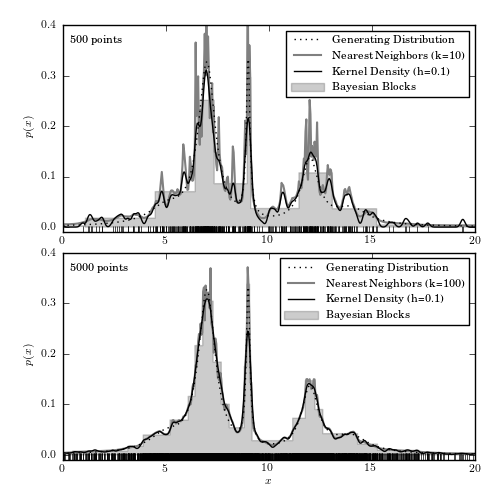Comparison of 1D Density Estimators¶
Figure 6.5
A comparison of different density estimation methods for two simulated one-dimensional data sets (cf. figure 5.21). The generating distribution is same in both cases and shown as the dotted line; the samples include 500 (top panel) and 5000 (bottom panel) data points (illustrated by vertical bars at the bottom of each panel). Density estimators are Bayesian blocks (Section 5.7.2), KDE (Section 6.1.1) and the nearest-neighbor method (eq. 6.15).

# Author: Jake VanderPlas
# License: BSD
# The figure produced by this code is published in the textbook
# "Statistics, Data Mining, and Machine Learning in Astronomy" (2013)
# For more information, see http://astroML.github.com
# To report a bug or issue, use the following forum:
# https://groups.google.com/forum/#!forum/astroml-general
import numpy as np
from matplotlib import pyplot as plt
from scipy import stats
from astroML.density_estimation import KNeighborsDensity
from astroML.plotting import hist
# Scikit-learn 0.14 added sklearn.neighbors.KernelDensity, which is a very
# fast kernel density estimator based on a KD Tree. We'll use this if
# available (and raise a warning if it isn't).
try:
from sklearn.neighbors import KernelDensity
use_sklearn_KDE = True
except:
import warnings
warnings.warn("KDE will be removed in astroML version 0.3. Please "
"upgrade to scikit-learn 0.14+ and use "
"sklearn.neighbors.KernelDensity.", DeprecationWarning)
from astroML.density_estimation import KDE
use_sklearn_KDE = False
#----------------------------------------------------------------------
# This function adjusts matplotlib settings for a uniform feel in the textbook.
# Note that with usetex=True, fonts are rendered with LaTeX. This may
# result in an error if LaTeX is not installed on your system. In that case,
# you can set usetex to False.
from astroML.plotting import setup_text_plots
setup_text_plots(fontsize=8, usetex=True)
#------------------------------------------------------------
# Generate our data: a mix of several Cauchy distributions
# this is the same data used in the Bayesian Blocks figure
np.random.seed(0)
N = 10000
mu_gamma_f = [(5, 1.0, 0.1),
(7, 0.5, 0.5),
(9, 0.1, 0.1),
(12, 0.5, 0.2),
(14, 1.0, 0.1)]
true_pdf = lambda x: sum([f * stats.cauchy(mu, gamma).pdf(x)
for (mu, gamma, f) in mu_gamma_f])
x = np.concatenate([stats.cauchy(mu, gamma).rvs(int(f * N))
for (mu, gamma, f) in mu_gamma_f])
np.random.shuffle(x)
x = x[x > -10]
x = x[x < 30]
#------------------------------------------------------------
# plot the results
fig = plt.figure(figsize=(5, 5))
fig.subplots_adjust(bottom=0.08, top=0.95, right=0.95, hspace=0.1)
N_values = (500, 5000)
subplots = (211, 212)
k_values = (10, 100)
for N, k, subplot in zip(N_values, k_values, subplots):
ax = fig.add_subplot(subplot)
xN = x[:N]
t = np.linspace(-10, 30, 1000)
# Compute density with KDE
if use_sklearn_KDE:
kde = KernelDensity(0.1, kernel='gaussian')
kde.fit(xN[:, None])
dens_kde = np.exp(kde.score_samples(t[:, None]))
else:
kde = KDE('gaussian', h=0.1).fit(xN[:, None])
dens_kde = kde.eval(t[:, None]) / N
# Compute density with Bayesian nearest neighbors
nbrs = KNeighborsDensity('bayesian', n_neighbors=k).fit(xN[:, None])
dens_nbrs = nbrs.eval(t[:, None]) / N
# plot the results
ax.plot(t, true_pdf(t), ':', color='black', zorder=3,
label="Generating Distribution")
ax.plot(xN, -0.005 * np.ones(len(xN)), '|k')
hist(xN, bins='blocks', ax=ax, normed=True, zorder=1,
histtype='stepfilled', color='k', alpha=0.2,
label="Bayesian Blocks")
ax.plot(t, dens_nbrs, '-', lw=1.5, color='gray', zorder=2,
label="Nearest Neighbors (k=%i)" % k)
ax.plot(t, dens_kde, '-', color='black', zorder=3,
label="Kernel Density (h=0.1)")
# label the plot
ax.text(0.02, 0.95, "%i points" % N, ha='left', va='top',
transform=ax.transAxes)
ax.set_ylabel('$p(x)$')
ax.legend(loc='upper right')
if subplot == 212:
ax.set_xlabel('$x$')
ax.set_xlim(0, 20)
ax.set_ylim(-0.01, 0.4001)
plt.show()
